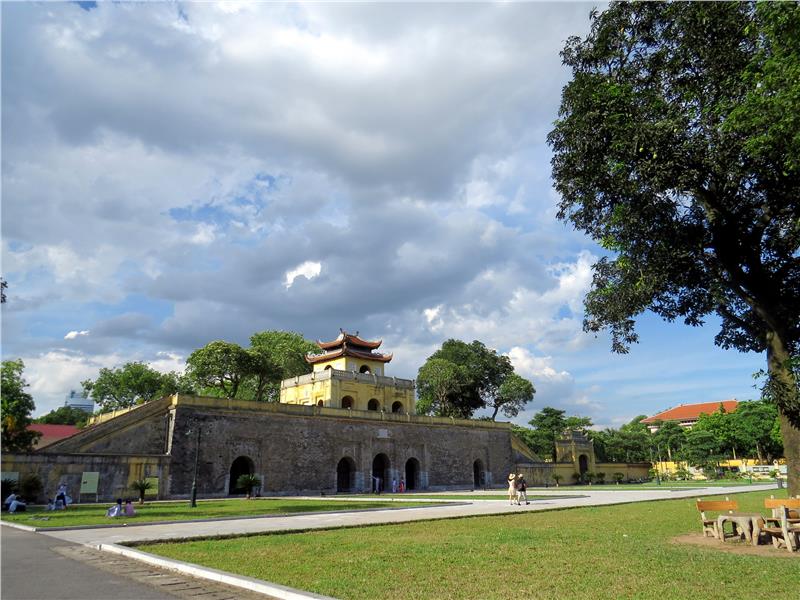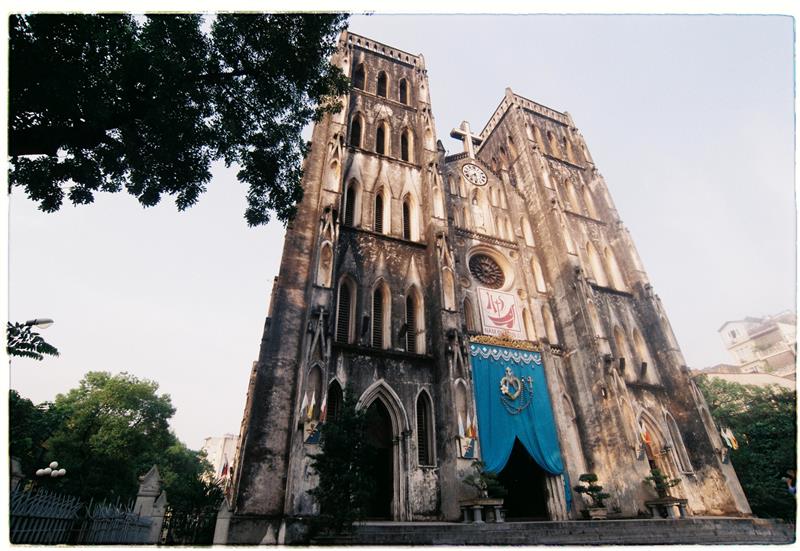Situated in two sides of Red River's riverbank between affluent and famous North Delta, Hanoi owns a prime location facilitating to become an important economic, political, cultural, social, and scientific center of Vietnam country.

Geographical location: Hanoi is located in Red River Delta, adjacent: Thai Nguyen, Vinh Phuc to the north; Ha Nam, Hoa Binh to the south; Bac Giang, Bac Ninh, Hung Yen to the east; and Hoa Binh, Phu Thio to the west. Situated in the right of Da River's riverbank and two sides of Red River, Hanoi retains a convenient location of an important economic, political, cultural, social, and scientific center and strategic traffic hub in Vietnam.
Terrain: There exist 2 main types of terrain in Hanoi, namely plain and hill. Among them, the plain accounts for 3/4 of the natural area. The majority of hilly terrain is located in Soc Son, Ba Vi, Quoc Oai, My Duc. There are some high peaks in the region, such as: Ba Vi 1,281m, Gia De 707m, Chan Chim 462m, Thanh Lanh 427m, Thien Tru 378m, Ba Tuong 334m, Soc Son 308m, Nui Boc 245m, Duc Linh 294m…
Climate: Hanoi climate is fairly typical for North climate characterized by a tropical monsoon climate: the hot summer with much rain and the cold winter with less rain. Accordingly, from May to September is the hot and rainy season. The average temperature in the season is about 29.2oC. From November to following year March is the winter with the the dry weather. The average temperature in the season is around 15.2oC. Between 2 these season, there exists 2 transition periods (April and October), which turns Hanoi into the city converging 4 seasons: spring, summer, autumn, and winter. Changes of 4 seasons in Hanoi weather make Hanoi its own beauty. Sightseeing tour season in Hanoi should be the autumn.

In 1010, King Ly Cong Uan, the first King in Ly Dynasty decided to establish a new capital in the region under the name of Thang Long. Through the reign of Ly, Tran, Le, Mac, Thang Long was the cultural, educational, and commercial center of whole North Vietnam. When Tay Son and Nguyen Dynasty came to power, the capital was moved to Hue; and Thang Long started its new name, Hanoi from 1831 under King Minh Mang. Then in 1902, Hanoi became the capital of the Indochinese Federation and was re-constructed and re-planned by the French. Over 2 wars defending the country, Hanoi has become the capital of the North, then unified Vietnam country, and kept its role until now.

According to the latest statistics, the population in Hanoi is about 6.2 million people. The population is primarily the ethnic Vietnamese (Kinh) accounting for 99.1%; other ethnic groups: Dao, Muong, Tay accounting for 0.9%. Vietnamese is commonly used in almost fields in the region. Also, based on the statistics in 2006, urban residents accounted for 41.1% and the proportion of rural residents was 58.1%. The average population density in Hanoi today is 1,875 people per km2, the number of agricultural population is about 2.5 million people.
Area: 3,324.92 km².
Districts:
- 10 Districts: Hoan Kiem, Ba Dinh, Dong Da, Hai Ba Trung, Tay Ho, Thanh Xuan, Cau Giay, Long Bien, Hoang Mai, Ha Đong.
- 1 town: Son Tay.
- 18 districts: Ðong Anh, Soc Son, Thanh Tri, Tu Liem, Gia Lam, Ba Vi, Chuong My, Dan Phuong, Hoai Đuc, My Đuc, Phu Xuyen, Phuc Tho, Quoc Oai, Thach That, Thanh Oai, Thuong Tin, Ung Hoa, and Me Linh (from Vinh Phuc).
Hanoi is the capital of Socialist Republic of Vietnam.

The position of Hanoi economic center has for a long time been established in the history. Many traditional villages, such as Bat Trang pottery, Co Nhue sewing, Van Ha handicrafts...is now recovering and growing. However, with the strong development of Saigon and South area, Hanoi only keep the second most important position in Vietnam economy.
In 2007, per capita GDP in Hanoi was up to 31.8 million VND; meanwhile the number of Vietnam's was 13.4 million Hanoi also got the foreign direct investment with impressive figures: 1,681.2 million USD and 290 projects. The city also home to 1,600 foreign representative offices, 14 industrial zones, and more than 16,000 industrial production facilities. Along with state-owned companies, private businesses also play an important role in Hanoi economy. In total, private enterprises contributed 22% of total social investment, more than 20% of GDP, 22% of the city budget, and 10% of export turnover in Hanoi.
Hanoi is a political center of Socialist Republic of Vietnam. Regarded as the heart of the country, Hanoi converges leaders of the Central Committee, the National Assembly, the Government, and social organizations. The capital is also home to National Congress of the Communist Party, National Assembly sessions, from which issued resolutions, guidelines, strategies for internal and external relations of Vietnam country. Besides, Embassies of many countries over the world are also located in Hanoi. All activities related to the diplomacy, visit, and submission of state letters, talks, treats of friendship and cooperation are carried out here.

Hanoi is one of 2 largest cultural centers in Vietnam (along with Ho Chi Minh City). There is a great number of libraries, theaters, together with historical relics, beautiful landscapes concentrating in the city. According to statistical data in mid-2008, Hanoi city owned 17 theaters, including 2 of them in Hoan Kiem and Hai Ba Trung District. Opera House is home to performances of classical art forms such as opera, chamber music, drama, as well as the center of conferences and meetings. Hanoi Cultural Friendship Palace is also an important performance venue for activities of culture, art, fashion, beauty pageant...along with scientific activities, seminars, exhibitions, and conferences. In addition, Youth Theater, Golden Bell Theater, Vietnam Drama Theater, Central Cai Luong Theater…are rendezvous of traditional artistic performance programs.
Hanoi also owns a most diversified museum system in Vietnam. A large part of them are historical museums, such as Vietnam Military History Museum, Vietnam history Museum, B52 Victory Museum, Museum of the Revolution...Besides, it can be told to Vietnam Fine Arts Museum, Vietnam Museum of Ethnology, Vietnamese Women's Museum. In total, Hanoi retains more than 10 museums, compared with the number of nearly 120 in Vietnam.
Hanoi is one of 3 regions concentrating festivals in Vietnam. Like other regions, traditional festivals in Hanoi are usually organized in the spring. Hanoi festivals focus on remembering historical characters and legend, such as St. Giong, Quang Trung, Hai Ba Trung, An Duong Vuong...Some festivals also organize unique folk games, namely Trieu Khuc festival, Thi Cam rice cooking competition, Ba Giang traditional kite-flying festival...
One of the largest festivals in the North Delta is St. Giong festival on annual 9 April in the Lunar Calendar (also known as Phu Dong village festival, Gia Lam). The festival's origin comes from a legend of St. Giong, one of 4 immortal people in Vietnam folk beliefs. Giong village festival is celebrated in a large area of 3km, including Thuong Temple, Mau Temple, and Kien So Pagoda. Apart from official festival in Phu Dong, St. Giong festival is also held in Xuan Dinh - Tu Liem (Hanoi), in Soc Son (Hanoi), and in Chi Nam - Le Chi - Gia Lam (Hanoi).

Beside St.Giong festival, Perfume (Huong) Pagoda festival also attracts the large number of tourists from mid-January until March in Lunar Calendar in Huong Son, My Duc. With the charming river scene, along with relics of Huong Pagoda, the festival is the destination of monks, Buddhists, pilgrims and tourists. Here, tourists actually are immersed in charming caves, Doi Cheo Mountain, Elephant Mountain, Raspberry Mountain, Chicken Mountain, Tien Pagoda, Giai Oan Pagoda, Cua Vong Temple, and magnificent Huong Tich cave. Huong Pagoda festival is one of the biggest and longest festivals in Vietnam.
Not only traditional festivals, Hanoi is also home to contemporary festivals with unique activities, attracting numerous domestic and foreign tourists: activities on welcoming New Year, National Day, Hanoi Liberation Day, South Liberation Day, and annual international festivals...
Tourism
Hanoi today maintains more than 4,000 monuments and beautiful landscapes, over 9,000 of which were ranked national relics, in company with hundreds of temples, pagodas, architectural works, and famous scenic spots. Compared to other provinces and cities in Vietnam, Hanoi owns a large potential to develop tourism. Right in inner districts, along with architectural works, Hanoi retains a large system of museums. The city also has many advantages in introducing Vietnam culture to foreign tourists through folk theaters, and traditional villages...
Cultural - historical relics: Co Loa Citadel and An Duong Vuong Temple, Temple of Literature, Imperial Citadel of Thang Long - Hanoi, Quan Thanh Temple, Hai Ba Trung Temple, Phu Dong Monument, Voi Phuc Temple, Ngoc Son Temple, Tran Quoc Pagoda, One Pillar Pagoda, Lang Pagoda, Hoe Nhai Pagoda, Lien Phai Pagoda, Kiem Lien Pagoda, Quan Su Pagoda, St.Joseph's Cathedral, Quan Chuong Gate, Presidential Palace, Opera House, August Revolution Square, Ho Chi Minh Mausoleum, Ba Dinh Square...
Beautiful landscapes: Long Bien Bridge, Thang Long Bridge, Chuong Duong Bridge, Hoan Kiem Lake, West Lake, Truc Bach Lake, Unity (Thong Nhat) Park, Thu Le Zoo, West Lake Water Park...

According to recent statistics, Hanoi today is the owner of 511 accommodation facilities with more than 12,700 operating rooms. Among them, there are 178 hotels ranked with 8,424 fully-equipped rooms. The price is considered to be quite expensive in Vietnam, about $ 126.26 per night for a room in a 5 star hotel; as a result, the efficiency of renting a 3-5 star hotel in Hanoi ranged from 80% to 90%. Apart from nine 5-star hotels, namely Daewoo, Horison, Hilton Hanoi Opera, Melia, Nikko, Sofitel Metropole, Sheraton, Sofitel Plaza, and InterContinental, Hanoi still has six 4-star hotels and about nineteen 3-star hotels. In addition, Hanoi is also one of the biggest tourism centers in Vietnam. Tourists actually have a chance to explore a great number of cultural - artistic architectures through many generations, and throughout the process of building and defending the country. Beautiful and charming natural landscapes, unique handicraft villages, attractive traditional festival in Hanoi...will be promisingly interesting tourism products.
